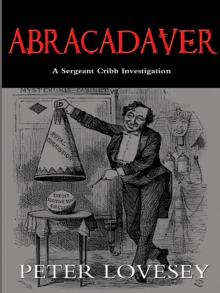 Bertie and the Seven Bodies
Bertie and the Seven Bodies The Headhunters ihmi-2
The Headhunters ihmi-2 Diamond Solitaire pd-2
Diamond Solitaire pd-2 Beau Death
Beau Death The Case Of The Dead Wait
The Case Of The Dead Wait The Vault
The Vault Abracadaver sc-3
Abracadaver sc-3 Mad Hatter sc-4
Mad Hatter sc-4 The Last Detective pd-1
The Last Detective pd-1 The Reaper
The Reaper The Circle
The Circle The False Inspector Dew
The False Inspector Dew Another One Goes Tonight
Another One Goes Tonight Abracadaver
Abracadaver Waxwork sc-8
Waxwork sc-8 Wobble to Death sc-1
Wobble to Death sc-1 Peter Diamond - 09 - The Secret Hangman
Peter Diamond - 09 - The Secret Hangman The Detective Wore Silk Drawers sc-2
The Detective Wore Silk Drawers sc-2 Waxwork
Waxwork The Summons
The Summons Mad Hatter's Holiday
Mad Hatter's Holiday Do Not Exceed the Stated Dose
Do Not Exceed the Stated Dose The Stone Wife
The Stone Wife The Secret Hangman pd-9
The Secret Hangman pd-9 Swing, Swing Together sc-7
Swing, Swing Together sc-7 Upon A Dark Night
Upon A Dark Night Bloodhounds
Bloodhounds Down Among the Dead Men
Down Among the Dead Men Diamond Dust
Diamond Dust Dead Gorgeous
Dead Gorgeous Murder on the Short List
Murder on the Short List The Usual Santas
The Usual Santas The Perfectionist
The Perfectionist Cop to Corpse
Cop to Corpse Rough Cider
Rough Cider The Tick of Death
The Tick of Death Bloodhounds pd-4
Bloodhounds pd-4 Remaindered
Remaindered The Detective Wore Silk Drawers
The Detective Wore Silk Drawers The Circle ihmi-1
The Circle ihmi-1 Stagestruck
Stagestruck The Secret of Spandau
The Secret of Spandau The Last Detective
The Last Detective A Case of Spirits sc-6
A Case of Spirits sc-6 The Headhunters
The Headhunters Goldengirl
Goldengirl The Summons pd-3
The Summons pd-3 Diamond Solitaire
Diamond Solitaire The Tooth Tattoo
The Tooth Tattoo The House Sitter
The House Sitter Swing, Swing Together
Swing, Swing Together